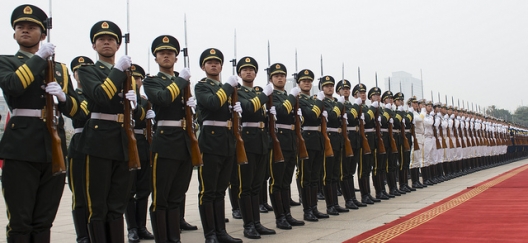 If the People’s Liberation Army went to war tomorrow, it would field an arsenal bristling with hardware from some of America’s closest allies: Germany, France and Britain.
If the People’s Liberation Army went to war tomorrow, it would field an arsenal bristling with hardware from some of America’s closest allies: Germany, France and Britain.
Most of China’s advanced surface warships are powered by German and French-designed diesel engines. Chinese destroyers have French sonar, anti-submarine-warfare helicopters and surface-to-air missiles.
Above the battlefield, British jet engines drive PLA fighter bombers and anti-ship strike aircraft. The latest Chinese surveillance aircraft are fitted with British airborne early warning radars. Some of China’s best attack and transport helicopters rely on designs from Eurocopter, a subsidiary of pan-European aerospace and defense giant EADS.
But perhaps the most strategic item obtained by China on its European shopping spree is below the waterline: the German-engineered diesels inside its submarines.
Emulating the rising powers of last century – Germany, Japan and the Soviet Union – China is building a powerful submarine fleet, including domestically built Song and Yuan-class boats. The beating hearts of these subs are state-of-the-art diesel engines designed by MTU Friedrichshafen GmbH of Friedrichshafen, Germany. Alongside 12 advanced Kilo-class submarines imported from Russia, these 21 German-powered boats are the workhorses of China’s modern conventional submarine force.
With Beijing flexing its muscles around disputed territory in the East China Sea and South China Sea, China’s diesel-electric submarines are potentially the PLA’s most serious threat to its American and Japanese rivals. This deadly capability has been built around robust and reliable engine technology from Germany, a core member of the U.S.-led North Atlantic Treaty Organization.
Arms trade data from the Stockholm International Peace Research Institute (SIPRI) to the end of 2012 shows that 56 MTU-designed diesels for submarines have been supplied to the Chinese navy.
“They are the world’s leading submarine diesel engines,” says veteran engineer Hans Ohff, former managing director of the Australian Submarine Corporation, the company that built Australia’s Collins-class conventional submarines.
MTU declined to answer questions about transfers to the Chinese navy, future deliveries or whether it supplies technical support or servicing. “All MTU exports strictly follow German export laws,” a company spokesman said.
CHINA’S MILITARY MARKET
The Chinese defense ministry says the PLA’s dependence on foreign arms technology is overstated. “According to international practice, China is also engaged in communication and cooperation with some countries in the area of weaponry development,” the ministry said in a statement responding to this series. “Some people have politicized China’s normal commercial cooperation with foreign countries, smearing our reputation.”
Transfers of European technology to the Chinese military are documented in SIPRI data, official EU arms trade figures and technical specifications reported in Chinese military publications.
These transfers are crucial for the PLA as it builds the firepower to enforce Beijing’s claims over disputed maritime territory and challenge the naval dominance of the U.S. and its allies in Asia.
China now has the world’s second-largest defense budget after the United States and the fastest growing military market. Many of Europe’s biggest defense contractors have been unable to resist its allure. High-performance diesels from MTU and French engine maker Pielstick also drive many of China’s most advanced surface warships and support vessels, SIPRI data shows. Pielstick was jointly owned by MTU and German multinational Man Diesel & Turbo until 2006, when Man took full control. . . .
European hardware and know-how fills critical gaps, however. It wasn’t supposed to play out this way.
The European Union has had an official embargo on arms shipments to China since the 1989 Tiananmen crackdown. Washington imposes even tighter restrictions on transfers of U.S. military technology to China, inspiring energetic efforts by Beijing to smuggle American gear and know-how. Europe’s embargo, however, has been far more loosely interpreted and enforced. Thus weapons and, perhaps more importantly for the PLA, dual-use technology have steadily flowed from America’s European allies to China.
EU arms makers have been granted licenses to export weapons worth almost 3 billion euros ($4.1 billion) to China in the 10 years to 2011, according to official figures from Brussels collated by the London-based Campaign Against Arms Trade. EU governments approved the sale of aircraft, warships, imaging equipment, tanks, chemical agents and ammunition, according to official figures.
Michael Mann, an EU spokesman in Brussels, said the EU arms embargo issued in June 1989 “does not refer to dual use goods.” It is up to individual member states to exercise control over such goods, Mann said.
From China’s perspective, France and the UK interpret the arms embargo most generously, mostly blocking only lethal items or complete weapons systems. France was by far the biggest EU supplier, accounting for almost 2 billion euros of these licenses. The United Kingdom ranked second with almost 600 million euros, followed by Italy with 161 million euros. The value of weapons actually shipped is difficult to extract from the data because some countries, including the UK and Germany, don’t report these figures. . . .
Europe has discovered a lucrative trade selling components, particularly if they incorporate dual-use technologies that fall outside the embargo.
“Nobody sells entire weapons systems,” says Otfried Nassauer, director of the Berlin Information Centre for Transatlantic Security and an expert on Germany’s arms trade. “But components, especially pricey high tech components, that works OK.”
Image: Chinese Military (photo: D. Myles Cullen/Department of Defense)
